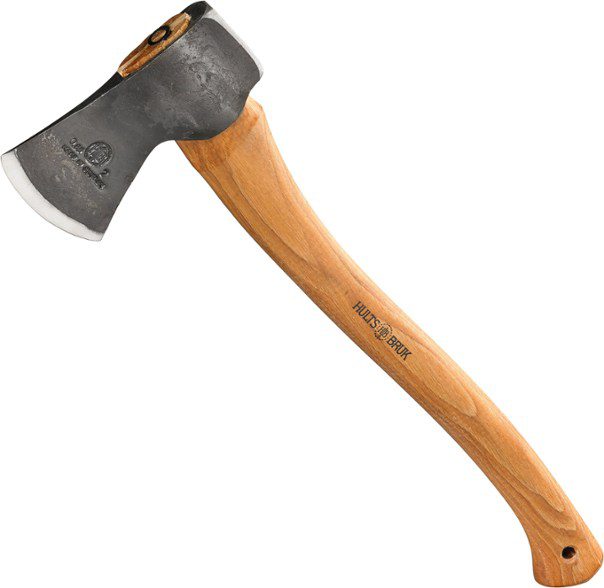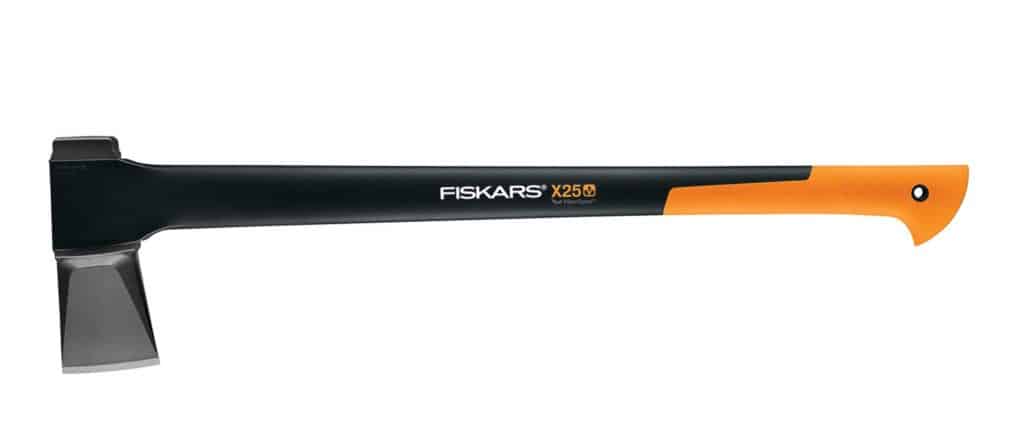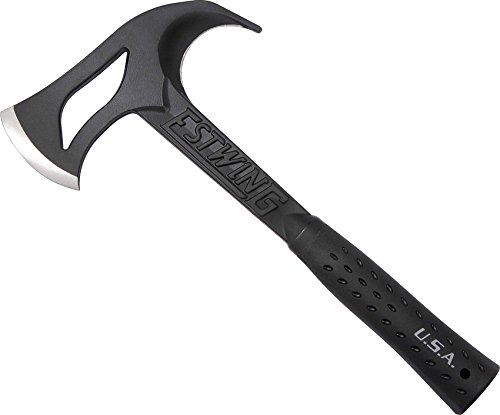Today’s best axes can be split between Swedish, Finnish, German, and Amercian-made tools. Choosing between these quality axes can be extremely difficult and requires a complete understanding of your requirements. If you are chopping firewood, a splitting axe is ideal, but choosing a full-size felling axe is required if you intend to fell large trees. You may also need to pick a smaller hatchet for camping or backpacking, so make sure you understand what you will use it for before deciding.
I have written extensively on all of these different products and have buyer’s guides for each category, so please do a deep dive into them if you want more information and insights. I have been working extensively with axes and logging tools for over a decade and hope to share my experience and knowledge with you so you don’t need to make the same mistakes I did.
In selecting the best axes in each category, I have considered the quality of construction, durability, value for money, and overall performance.
1844 Helko Werk Germany Classic Tasmania Competition Axe
- C50 High Carbon Steel Head
- Handmade in Germany
- 31 Inch Grade A American Hickory Handle
- 4 Pound Axehead / 6 Pound Total Weight
- 31-inch Hickory Handle
- Hand Forged 3.3 lb Axehead
- 20 Year Warranty
- Made in Sweden from the World's Premier Forge
- Total Weight - 2.75 pounds
- 2.0 Pound Solid Swedish Steel Axehead
- 20 inch American Hickory Handle
- Ideal for Bushcrafting and Camping
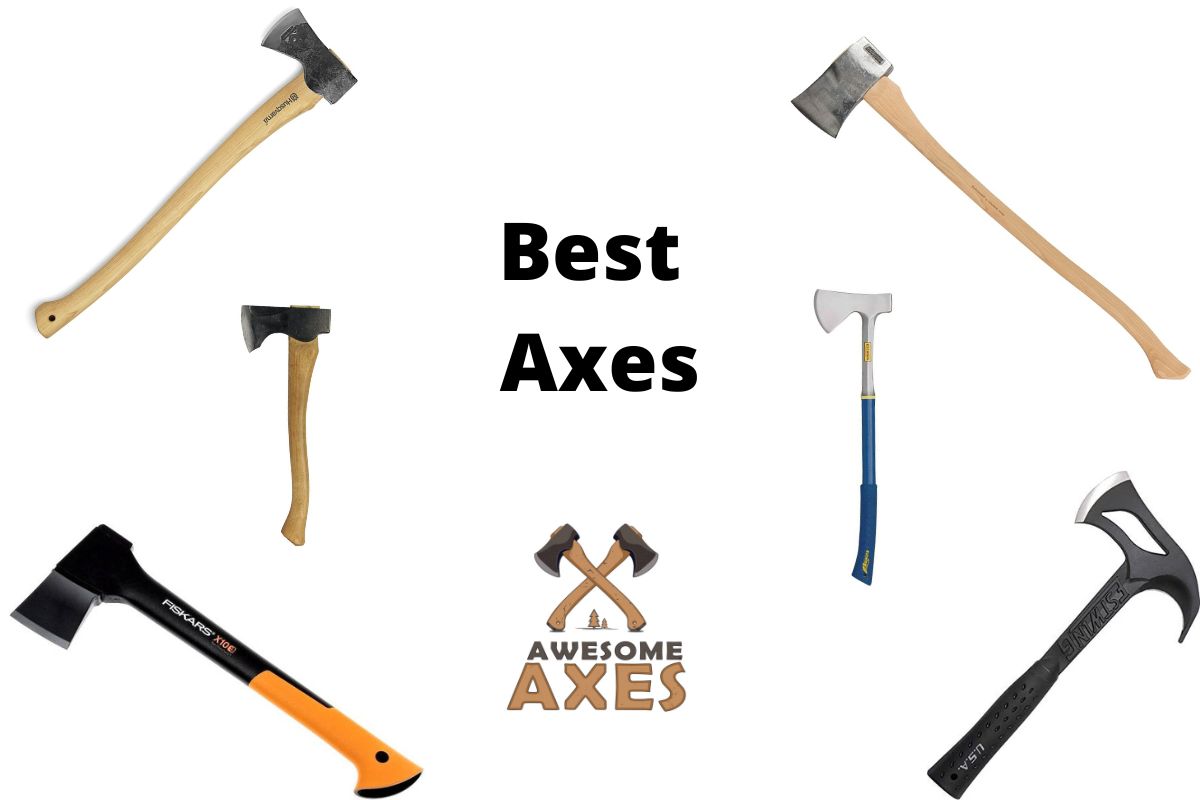
Table of Contents
1. Fiskars X7 Hatchet
I generally split up hatchets into three categories – traditional wooden hatchets with a steel head, composite hatchets made from synthetic materials, and tactical hatchets that are thinner, lighter, and designed for throwing.
One of the most popular hatchets, and rightly so, is the Fiskars X7 Composite Hatchet. It is specially designed for chopping kindling and has several features that make it at the top of my list. Fiskar’s claims that the composite handle material (called FiberComp) is virtually unbreakable.
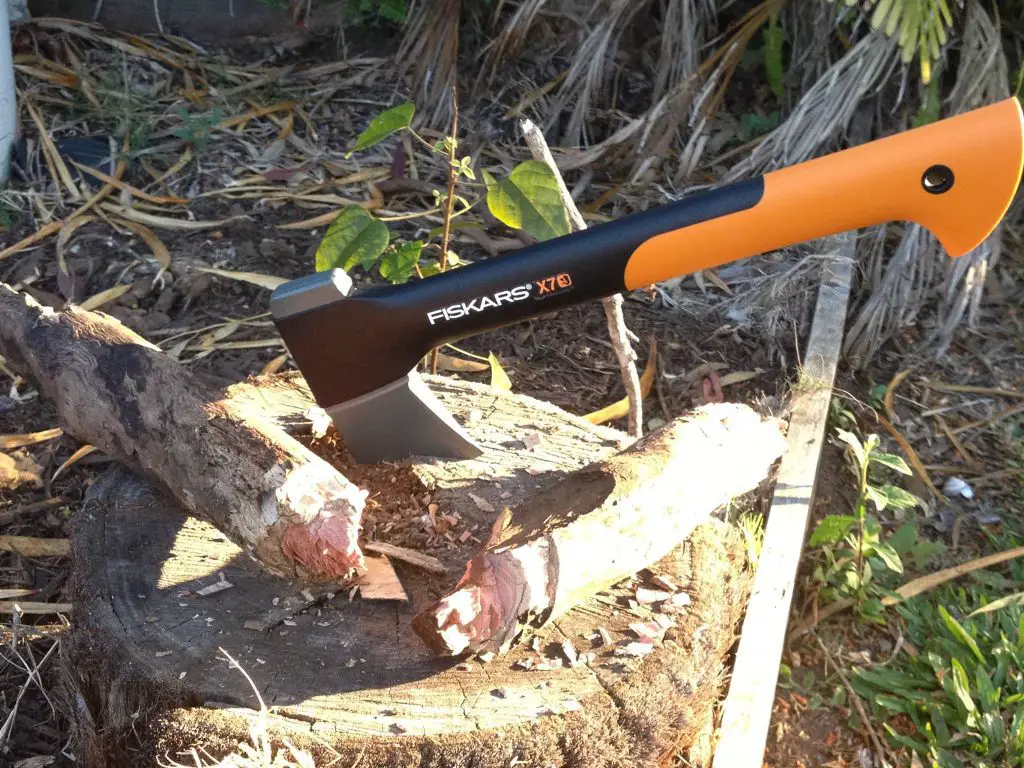
This hatchet is top of my list because of its quality and performance. If you choose this axe, then you won’t have any regrets. I own the Fiskars X10, a slightly larger model than the X7, and it handles very well as a camper axe.
Pros
- The composite handle is almost indestructible
- Low friction coating prevents the axe from getting stuck in the wood
Cons
- My main problem with composite handles is that the entire axe needs to be thrown away if it breaks
2. Gransfors Bruk American Felling Axe
If you’re felling trees – not just splitting dried logs or rounds of wood, making kindling for a fire, or cutting off branches – you must choose the right type of axe for it. Felling axes need a thin profile for deep cuts that bite big wood chips from the tree.
They also need to be big and hefty for those high-power swings. That’s because felling a tree is hard work, and smaller axes, with less heft in their axehead and less punch behind each swing, aren’t very practical for bigger trees (especially when they’re hardwoods).
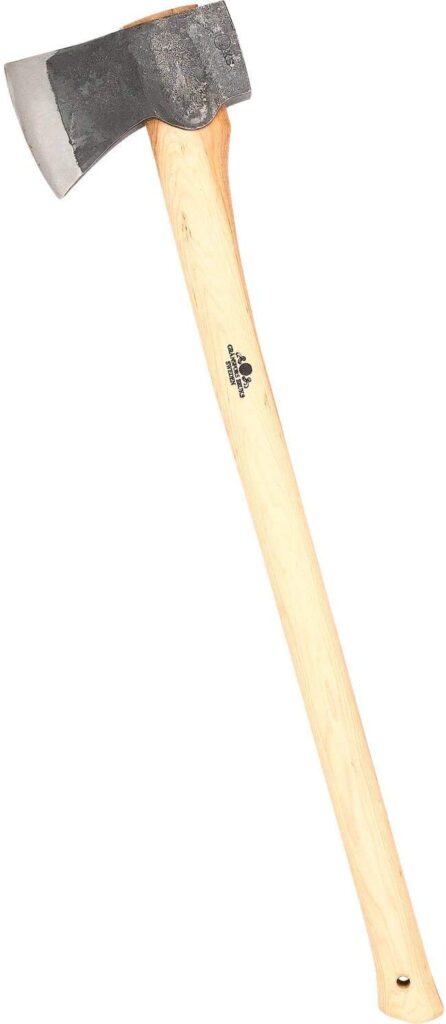
The Gransfors Bruks American felling axe is a cream of the crop of felling axes. While not as large as some felling axes on the market (it comes in at a length of 31 inches or 79 cm), the ultra-sharp bite of the hand-forged 3.3 lb axehead (with a total axe weight of 5.5 lbs) allows you to fell even very large hardwoods, and make short work out of softer resinous trees such as pine and spruce.
People have reported felling large maple trees with this straight out of the box without it noticeably losing its edge.
Pros
- It holds its edge well
- This is the best felling axe I have ever used
- Hand forged axe head
Cons
- It isn’t as long as a full sized 36-inch felling axe
3. Fiskars X25 Splitting Axe
If you’re splitting a lot of wood for burning throughout the winter or year, you’ll be much happier if you have an axe suited for the task. Splitting axes and mauls are made to split wood, whether cured, dry rounds of wood for firewood or green, freshly-felled logs.
Their profiles are wider and cheeks – fatter, their axeheads are generally heavier than those of regular axes, and the polls – the back end of the axehead – are often hardened, meant for use as a hammer to drive in splitting wedges. Wood-splitting axes and mauls won’t make good felling axes, but they’ll tear apart wood when it’s on the ground better than any other axe.
The Fiskars X25 28-inch splitting axe is a great tool and lives up to its reputation for making well-designed and tough-as-hell tools and selling them for a fair price. How is that? The Fiskars X25 has a composite material handle that’ll take much more use and abuse than wooden handles. Its axehead starts with a very sharp and thin edge but then widens dramatically towards the handle.
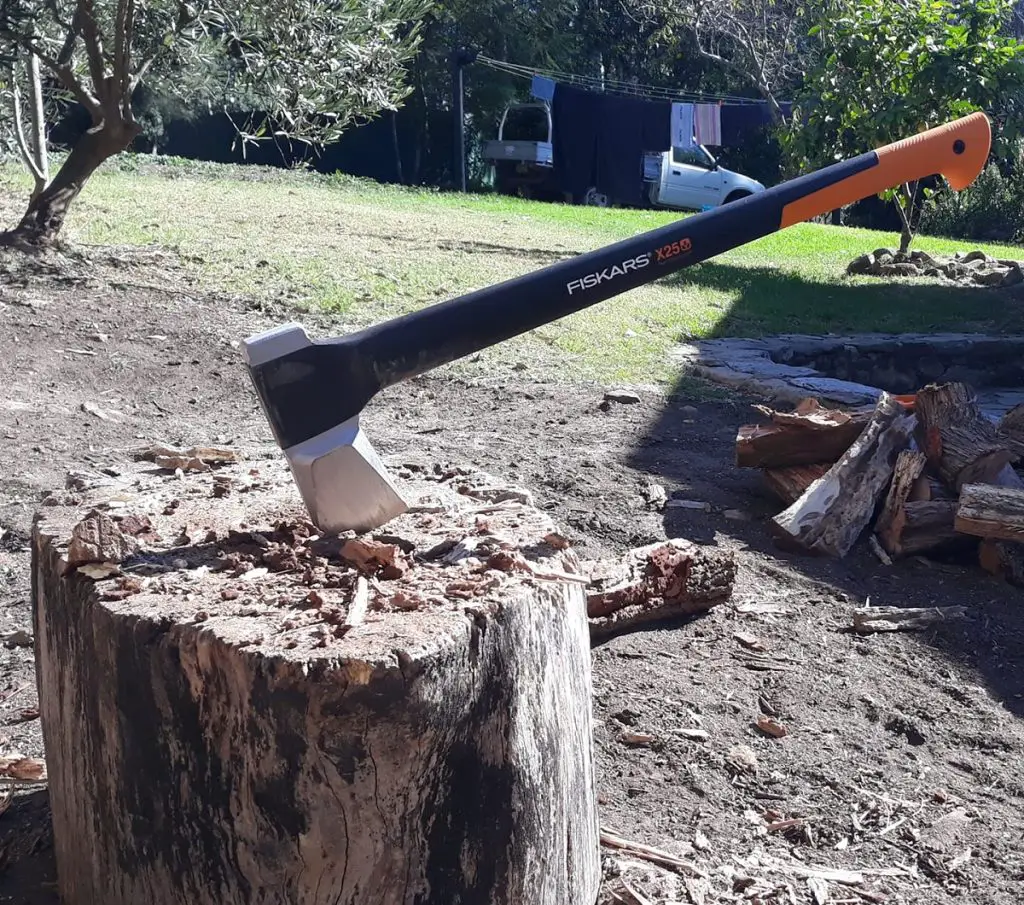
This means it’ll bite well into the wood, but immediately after that, it’ll force the wood fibers apart like a maul. This, along with the low-friction coating on the axehead, means that it will never get stuck in the wood as other axes might, a real boon if you’re splitting lots of wood at a time or throughout the season.
Pros
- Wide cheeks split wood fibers apart
- Low friction coating prevents the axehead from getting stuck
- Lightweight composite handle
- Hardened poll for driving in splitting wedges
Cons
- 28-inch handle lacks the ability to generate as much power as a full sized 36-in splitting axe
4. 1844 Helko Werk Competition Racing Axe
While lumberjack axes have mostly been replaced by chainsaws and other heavy machinery in forestry, the lumberjack tradition is still alive and well in competitions. It’s a true test of skill and endurance, as chopping through big pieces of wood as fast as possible is no easy task.
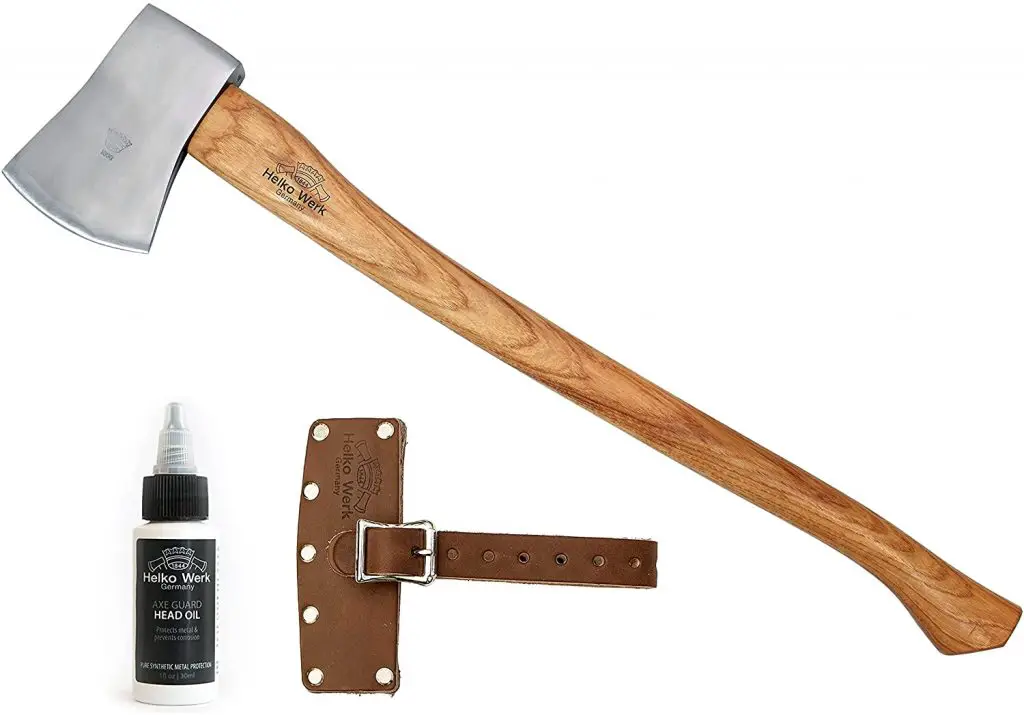
The Helko Werk Tasmania Competition axe is probably one of the top axes you can get for axe racing and competitions. It’s handmade in Germany from C50 high carbon steel and comes at a hefty weight of 6 lbs overall with a 4-pound axehead.
The handle length is 31 inches, and it comes with a protective leather sheath and 1 oz. of axe guard oil. This axe does the trick, as German engineering and manufacturing standards mean it is built to a very high standard based on the classic Tasmanian axe pattern.
Pros
- Extremely high performing competition axe
- C50 high carbon steel
- Powerful 4 lb axehead
Cons
- Much more expensive than alternate axes
5. Fiskars Brush Axe
Brush axes and billhooks are great tools to clear thick brush, bushes, and saplings without using loud chainsaws, hedge trimmers, or other power tools. These tools have a long history and have been used for thousands of years worldwide. Whether cutting through a backwoods trail or clearing your overgrown backyard, brush axes and billhooks are your friends.
Fiskars produce excellent modern versions of classic designs, and the Fiskars Brush Axe is one of them. The blade is 9 inches long and coated with an anti-rust, low-friction coating to help it slice through wood and be easier to pull out if it does get stuck. The handle is a composite material that the blade is fit-molded into, meaning that the blade will not separate from the handle unless the handle breaks, which Fiskars handles rarely do.
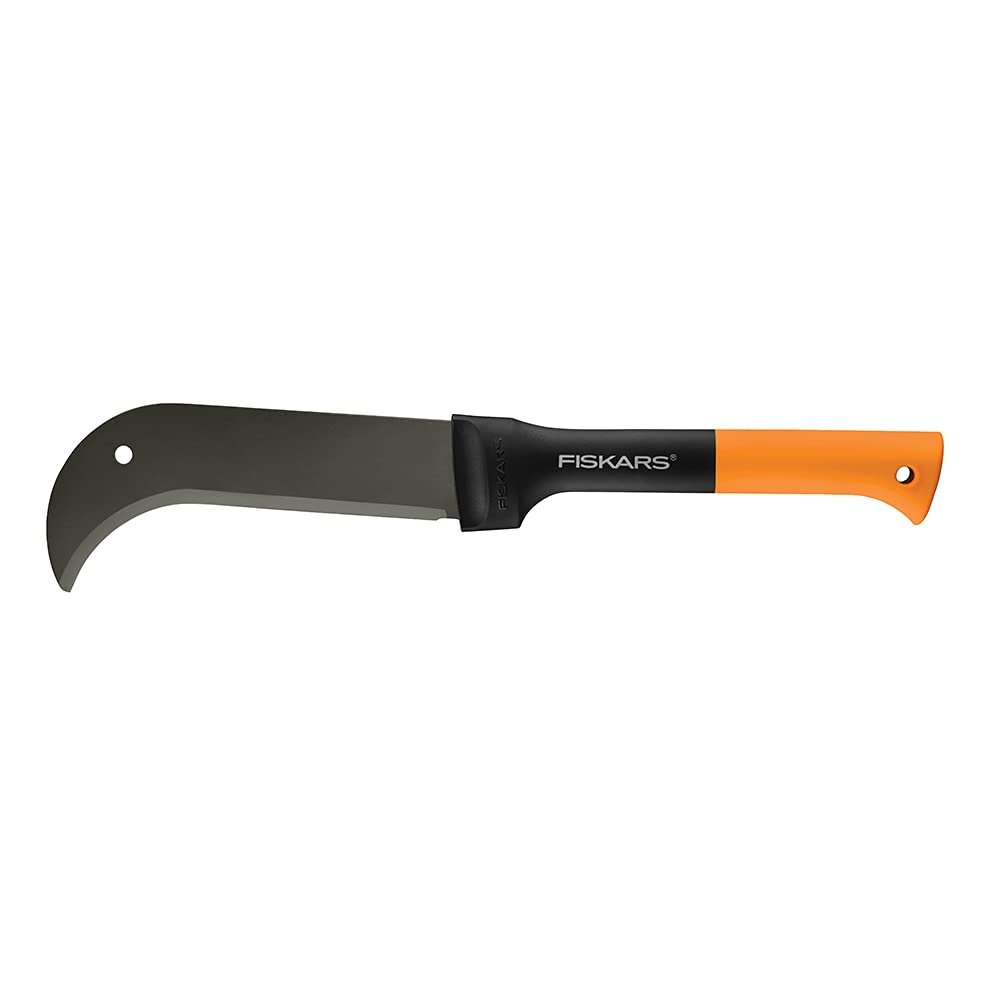
You can easily buy another one ten years later at such a low price point. It comes with a sheath for safe carrying and handling when not in use. Overall, the Fiskars Brush Axe is an excellent tool by a reputable Finnish company. Great value for the money.
Pros
- Composite handle
- Low friction coating
- Ideal for clearing trails and brush
Cons
- Difficult to reach higher branches or knee height grasses
6. SOG FastHawk Tactical Tomahawk
Tomahawks are great tools for many purposes – bushcraft, self-defence, axe throwing competitions, and even for hunting and in emergencies. Tactical tomahawks take the traditional wood-handled tomahawk design to the next level – more durable and sometimes with more features – such as a pick or hammer on the back or poll side of the axehead. Some even have a crowbar at the end of the handle.
The SOG Tactical Tomahawk is one of the most popular models out there, and for good reason. It has a light, sharp, sleek design and solid construction. It’s also a multi-purpose axe – apart from the edge, it has a spiked poll end and a checked hammering surface.
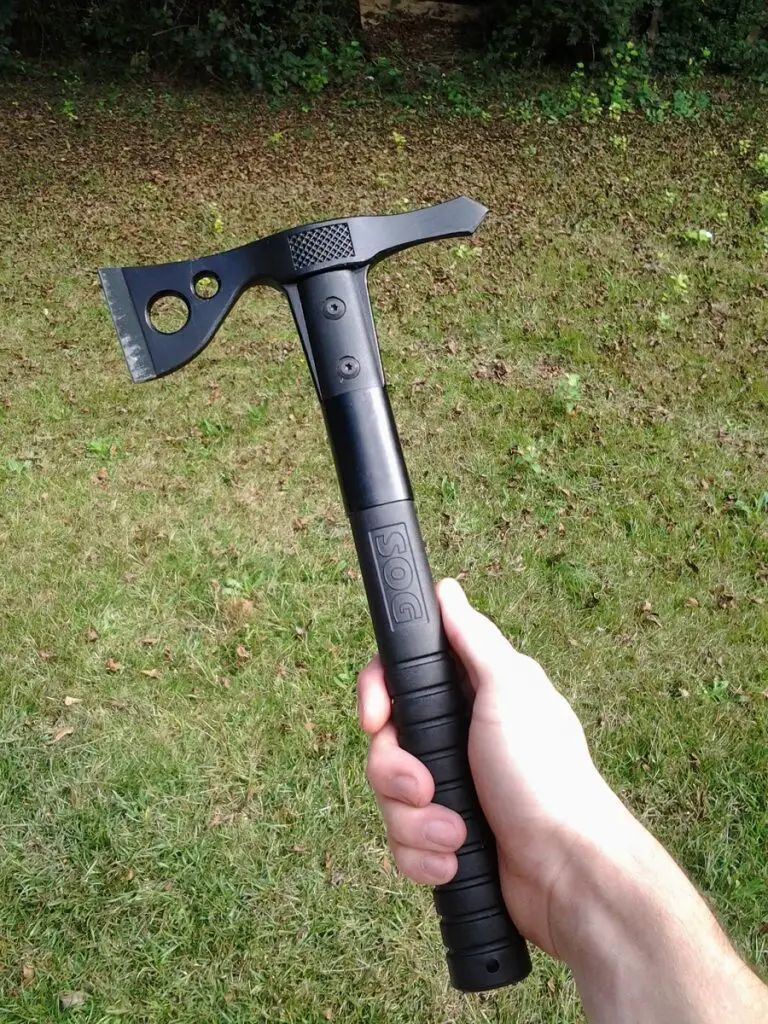
The straight cutting edge is 2 inches long, more than enough to penetrate whatever you throw it at and also usable for cutting small saplings and branches. It’s marketed as a throwing axe, which is what tomahawks are, but the hammering surface on the axehead’s side is useful when camping for hammering tent stakes into the ground.
The poll spike can be used for breaking up ice or earth. The axe can, of course, be used for self-defence against aggressive animals.
Pros
- Spicked poll
- One of the most popular throwing tomahawks
Cons
- Shorter cutting edge at only 2-inches
7. World Axe Throwing League Competition Throwing Axe
Axe throwing is growing in popularity every year. From casual nights out with friends to serious axe-throwing events where people compete according to official rules and regulations, axe throwing has something appealing for all levels of throwers – from absolute beginners to hardcore enthusiasts. Just as important as enthusiasm, though, is also the axe you’ll be throwing. Cheap axes dull and chip easily, are hard to throw and take some of the joy out of throwing them.
The best overall throwing axe is made by the World Axe Throwing League. It is specifically designed for axe-throwing competitions, which is evident in its thin profile and sharp blade, making it much more likely to stick into the wooden target. It has a 16-inch American hickory handle that is extremely well-balanced. The handle is longer than most, but that is because it is designed to be cut down to adjust based on your height and throwing style.
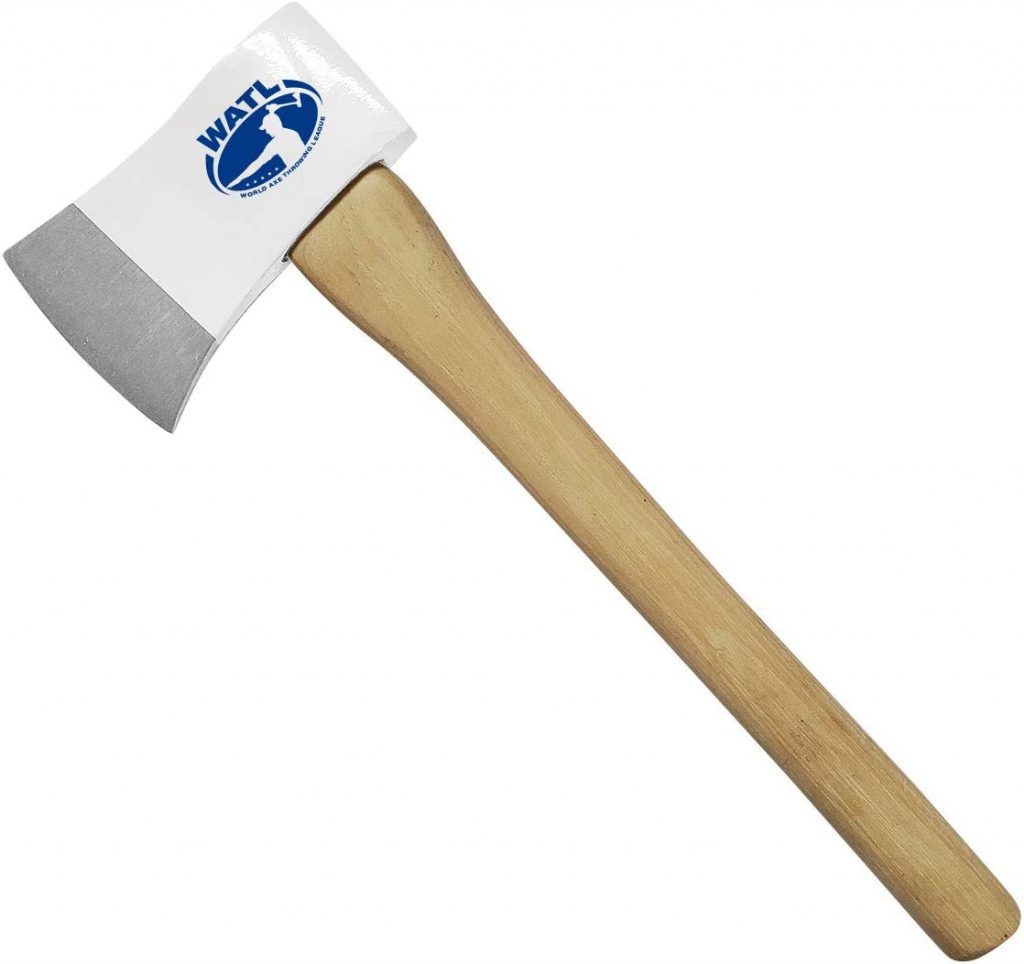
If you are a complete beginner to axe throwing, I recommend going with this WATL Competition Thrower so you can practice with the exact axe you will be using when you start competing properly.
Pros
- Official throwing axe for competitions
- Well balanced axe head and straight handle
Cons
- While the handle is designed to be cut to length, make sure you don’t ruin it forever by cutting off too much
8. Hults Bruk Aneby Bushcraft Axe
Bushcrafting and going into the woods is hundreds of years old and closely and brightly linked to the national histories of North America. Going into the woods for a couple of days or weeks is growing in popularity, especially with more people getting out of cities and going into the great outdoors.
The Hults Bruk Aneby is a 20-inch, 2-lbs (axehead weight, total weight 2.75 lbs) all-purpose camp and bushcraft axe. This is the cream of the crop of bushcraft axes, a true “Goldilocks” axe that is neither too long nor too short, too heavy or too light for the tasks you’d mostly be doing while bushcrafting and backpacking.
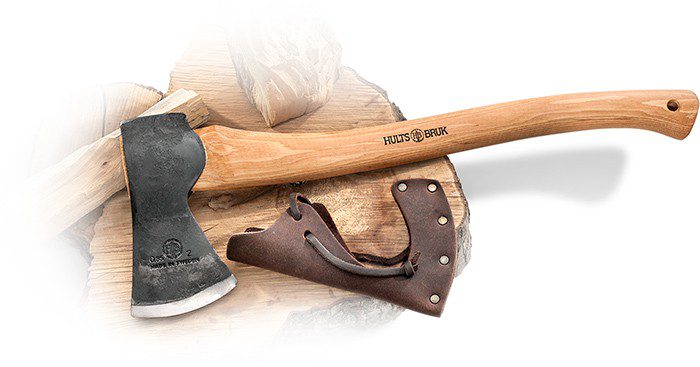
Carefully hand-forged in the Hults Bruk forge in Sweden, the Aneby will – despite its size – go through even tough hardwoods. Its 3.5-inch cutting edge is heat-treated and hardened well, so it’ll hold a sharp edge for a long time (and it comes razor-sharp straight out of the box).
The axehead is high-quality Swedish carbon steel – the precise details are proprietary information, but the Swedes – and especially the big two axe makers, one of which is Hults Bruk – are known for making great steel.
Pros
- High quality Swedish carbon steel
- Hand forged axehead
- Ideal for bushcraft and backpacking
Cons
- The 20-inch handle is portable, but lacks the power to fell anything other than small trees
9. Estwing Hunter’s Axe
Axes have been used in hunts starting in ancient times. After the animal has been brought down, axes could deliver a finishing blow and process the game on the spot. Hunting axes are also still a thing nowadays – they’re used for skinning hunted game and processing it into smaller parts for easier carrying and transportation.
This is a single-piece forged steel hatchet made by Estwing in Rockford, Illinois. It’s 14.5 inches long, weighs 2.85 lbs, and has a 3-inch cutting edge.
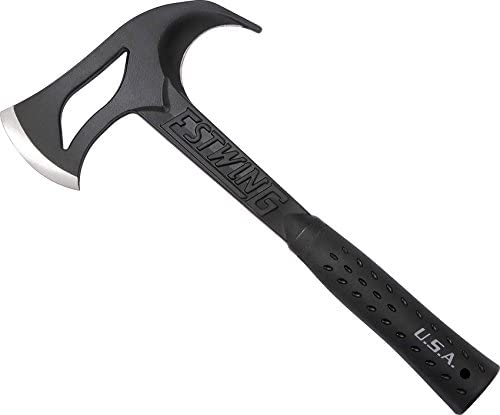
What’s great about this axe – and makes it a hunter’s axe – is the gut hook on the poll side of the axehead. Gut hooks on knives and such can have the problem of being too small – getting stuck up with hair and such.
The large gut hook on the Estwing Hunter’s axe doesn’t have this problem, plus the handle allows you to leverage your grip and even use two hands to open up the deer or other large game. For example, the cutting edge can be used as a cleaver – for cutting through muscle and connective tissue to split the pelvic bone.
Pros
- Large gut hook on the poll
- The axe can be used as a butcher’s cleaver
- Made in USA
- Shocked reduction grip handle
Cons
- Single piece steel design is heavier than similarly sized alternatives
10. Norse Tradesman Viking Axe
Viking axes – faithful historical replicas and fun but less historically-accurate designs alike – are widely available online. The popularity of the hit show Vikings and the main character Ragnar Lothbrok – and his battle axe – boosted interest in Viking axes for many people. A Viking axe is a great gift for yourself, a friend, or a loved one who is an axe or Viking history enthusiast.
The Norse Tradesman Viking Battle Axe is just a bit shorter at 24 inches and has a curved handle. However, it is more historically accurate to what the Viking axe design was, using what is known as a “skegg” axe head design. The top of the 6-inch edge doesn’t curve upwards nearly as much as other replicas of Viking axe do, and instead, the beard of the axe is longer and truer to history.
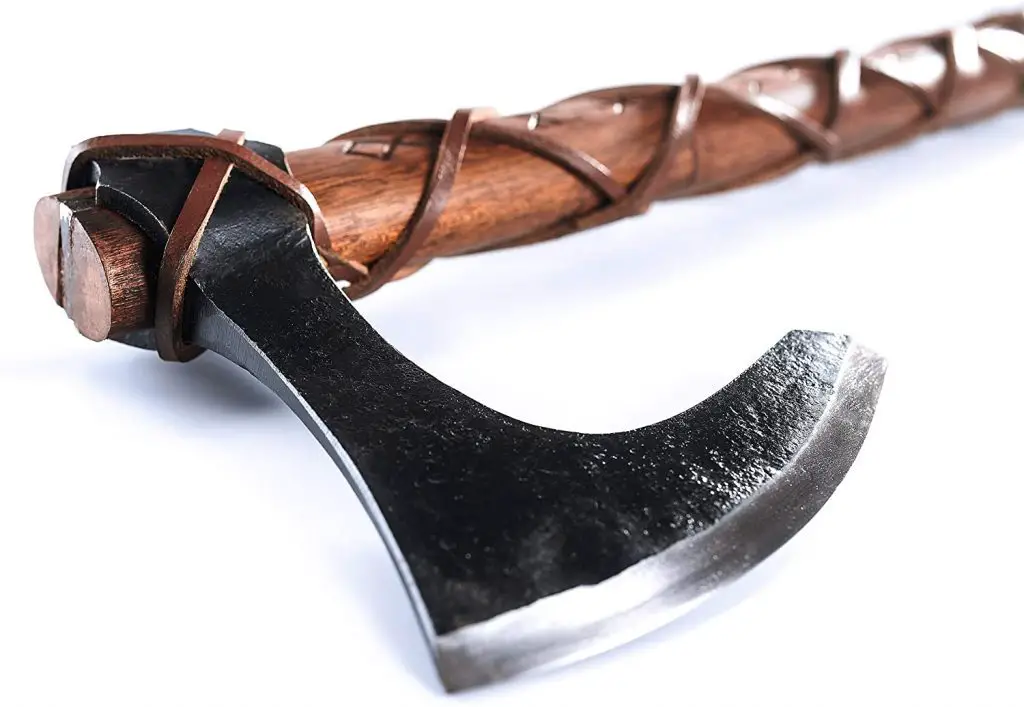
The handle is made from rosewood, a very hard and sturdy wood, with leather strips wrapped around it. It has Norse Elder Futhark runes carved into the handle for that extra Viking touch. Finally, the 1095 high carbon steel axehead (with a hardness of 56-58 HRC) has been heat-treated for excellent edge retention.
Pros
- 1095 high carbon steel
- Rosewood handle
- Heat treated edge stays sharper for longer
Cons
- The top of the axehead doesn’t curve upwards as much as other Viking axe replicas
11. Estwing Double Bit
Double bit axes are a classic design, valued by loggers and frontiersmen since it was introduced to America in the 1800s. The heavy head makes it a great choice for felling trees – at the same time, each of its bits (or edges) can be designed for or used for different purposes.
Sometimes one edge is a bit thicker and wider and is suited to splitting logs or rounds of wood. The other edge is thinner and more suited for deep cuts in standing or felled trees. Or the bits might be identical, but one edge is used for rough and dirty tasks that dull an edge quickly – for example, chopping through roots and the grit they’re covered in.
Estwing is known for their nearly-invincible forged steel axes – with axehead and steel handle fused, you can be safe knowing that the head won’t fly off or the handle break. It is also proudly manufactured in the USA, and among the large double bit axes probably one of the best in terms of value and quality for the money you spend.
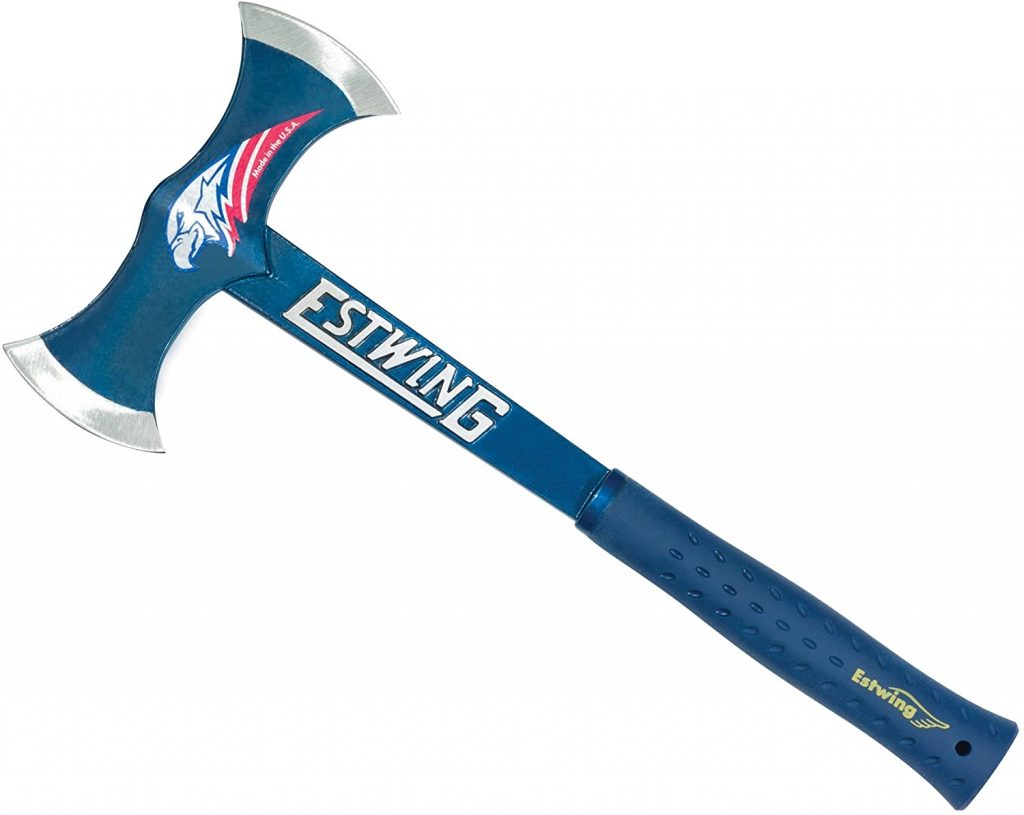
The only drawback is that being a steel-handled axe, it is heavier than other axes with wood or fiberglass handles. That, along with the fact that double bit axes are naturally heavier, means that the Estwing is a hefty boy. Of course, if you want to go at those trees and wood, the extra weight will add force and bite to your swing!
Highly recommended if you’re ready to handle the extra weight.
Pros
- Almost indestructible
- Shock reducing handle grip
- Made in America
Cons
- Steel axes are heavier than wooden alternatives
12. Estwing Carpenter’s Axe
If you’re looking to do woodworking above and beyond felling trees or splitting firewood, you won’t get very far unless you have an axe suited to the task. Roofers, framers, carpenters, log cabin builders, and general contractors must split wood, drive nails in or pull them out, break something apart, and more.
The Estwing Carpenter’s hatchet is a solid (literally), functional half-hatchet perfect for building, demolition, and woodworking. It comes cast in one solid piece, meaning you never have to worry about the axehead coming loose as you work.
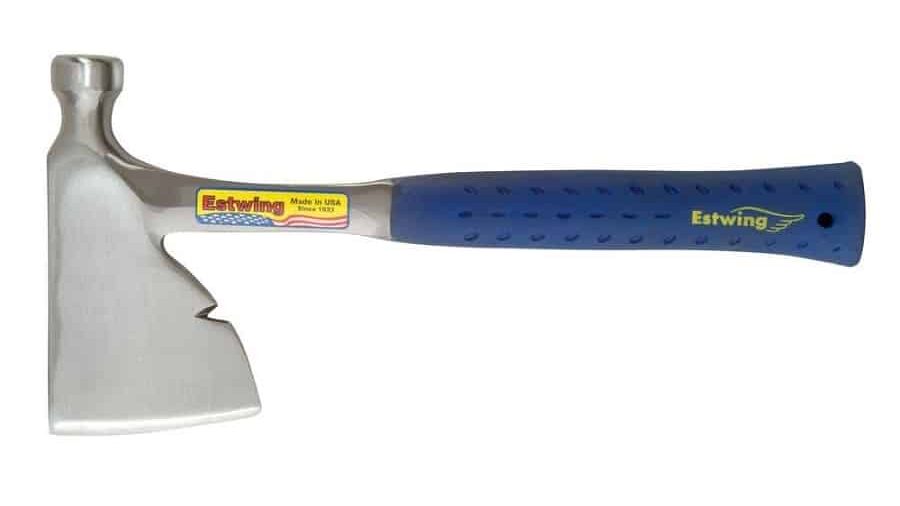
The solid steel handle is wrapped in a blue shock reduction grip to protect your wrists from the impact of the axe against whatever you’re striking. The grip is serious and fulfills its task very well – it doesn’t slip, deadens the shock from almost any blow, and is long-lasting and durable. You won’t find it coming apart after a day of use.
Pros
- Shocked reducing grip
- Made in America
- Notch for removing nails
- Hammer poll
Cons
- Single piece steel axes are heavier than other options
13. Husqvarna Carpenter’s Axe
Consider your needs carefully for backpacking – are you going to be walking a lot and doing light work, such as chopping off small dead tree branches, splitting pieces of wood for kindling and firewood, and so on, or do you think you might do heavier work such as trail or campsite clearing?
If it’s the first, you’ll want something light. If it’s the second, a longer and heftier backpacking axe that can be used with two hands would be more appropriate for you.
The Husqvarna Carpenter’s axe, at 20 inches and 2.4 pounds, is the hefty workhorse of small backpacking axes. It is designed as a carpenter’s axe and excels at carving and shaping wood. Its symmetrical bevel makes it more all-purpose and easier to use than many carpenter’s axes with a single-beveled blade.
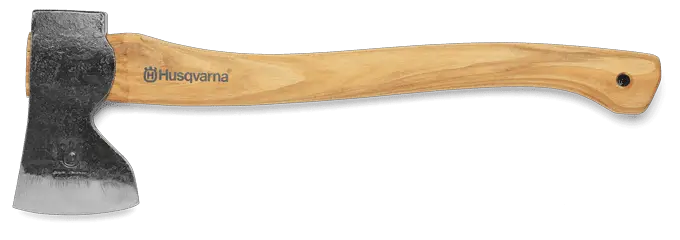
You can easily make a feather stick (for easy fire-starting), but it’s not as if the carpenter’s axe is good only for such small tasks around your campsite. Its weight gives you more heft and allows you to put more force into your swings if you’re chopping down small trees or splitting logs. And that’s where the beauty of this axe lies.
It’s equally good at small tasks (like carving) as it is at bigger ones, such as limbing trees that have fallen across a trail.
Pros
- Bearded axe head allows you to place your hand directly behind the blade, which is great for carving
- Versatile for many tasks
- All purpose symmetrical bevel
Cons
- Lacks the quality of the Swedish manufactured axes
14. Council Tool Pulaski Axe
Pulaski axes are versatile and heavy-duty tools used in wildland firefighting, forestry, and gardening. A Pulaski Axe consists of an axehead with an axe bit on one side and an adze on the other. They can be used to chop down trees one moment, churn up earth, and dig up or cut through roots the next. If you can’t construct a firebreak fast enough because your axe bit is dull after striking roots and the ground too many times, you might lose your home – or your life.
The legendary American company Council Tool made the classic red-enamel Pulaski axe in the USA. It’s a large and serious tool that packs a great punch, allowing you to chop down trees using its four-and-a-half-inch cutting edge and punch through and pull out roots using its adze. Since it’s made in the USA, using high-quality US steel and materials, you know it’ll serve you well and won’t fail you in hard conditions. Highly recommended as a serious working tool.
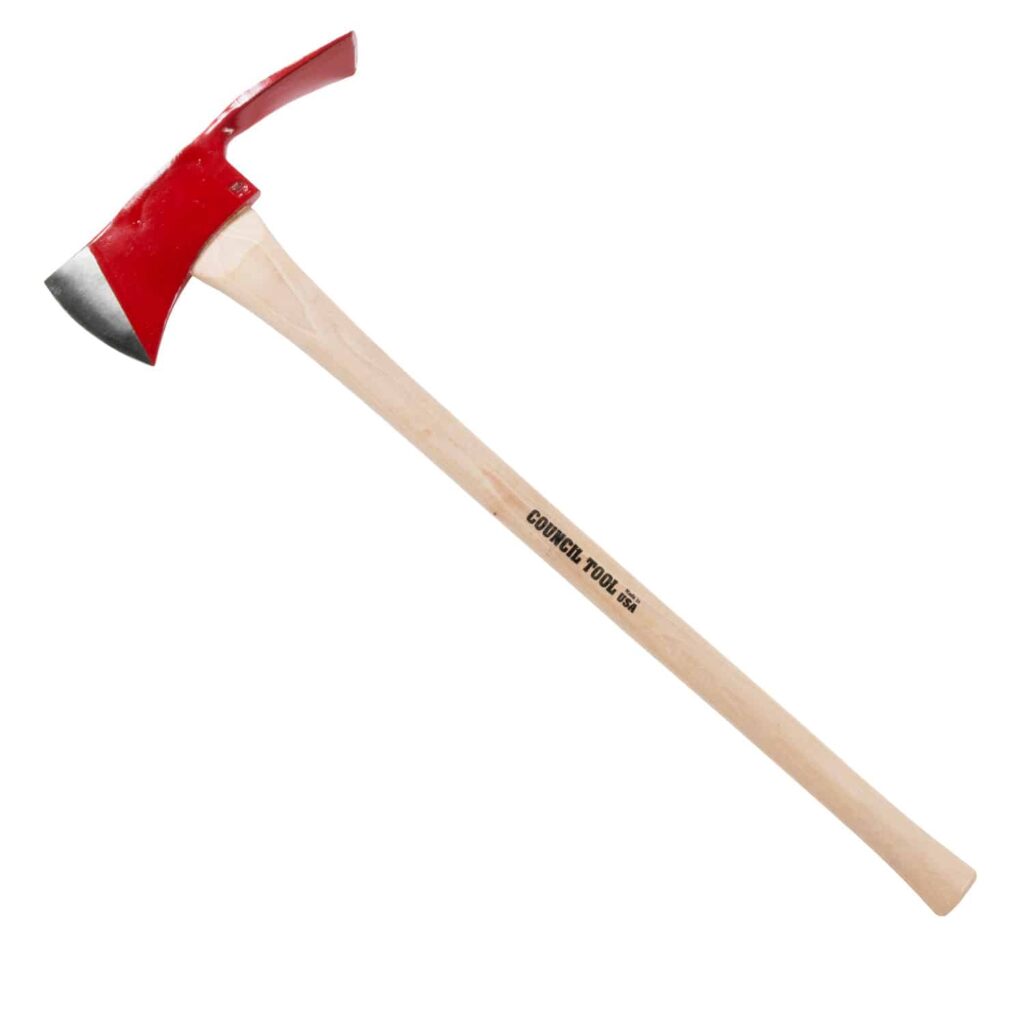
This steer hide leather sheath for Pulaski axes is a good accessory to pair with your Council Tool Pulaski axe, which doesn’t come with one. It’s riveted for extra durability, and a strap connecting the two sides has eight holes to adjust for Pulaski axeheads of different lengths and sizes.
Pros
- Two tools in one – chopping axe at the front and attack on the poll
- Steer hide leather sheath
Cons
- This is a full-size axe that is very heavy and is difficult for smaller people to use
- Unless you are a firefighter, you will likely be able to find a more suitable axe design
Axe Buying Guide
It can seem overwhelming when these different axes are shown, but they all have their own features and purposes. You only need to try to cut down a tree with a splitting axe to realize that particular axes can only do specialized jobs. I have compiled a buying guide to help explain some of the key criteria and specifications for each axe.
Handle Material – Wood or Fiberglass?
There are generally two popular materials for axe handles – American hickory or fiberglass composites. Wooden handles are the traditional design and, in my opinion, the most aesthetically pleasing. They are easily replaceable if they break and can be sanded and oiled whenever required. A wooden handle can be maintained and kept in good working order.
A fiberglass composite handle is almost impossible to maintain. However, they are also much less likely to break or get damaged. They are also generally lighter and can be more affordable in some circumstances.
You can also get steel handles generally built in a full tang, one-piece design with the axehead. These are generally only available in smaller hatchets.
Axehead Style
There are literally hundreds of different types of axes available. Some may have a beard where the toe drops below your top hand, allowing you to apply pressure directly behind the edge, which is ideal for carving. Others may have a hardened flat pole on the back side so that a hammer can force the axe through hardwood.
The length of the cutting edge also impacts the style. Longer axe heads can cut through more wood in one strike by often can’t penetrate as deeply due to the increased friction resistance.
Axehead Steel
The most common steel used for axeheads is carbon steel. The amount of carbon in the steel is used to describe its properties. You will often see the numbers 10XX, which describes the percent of carbon, so 1060 has 0.6% carbon.
Most axes use medium-carbon steel, which is often called 1050 or 1060. This is versatile steel and gives a good range of performance.
High-carbon steel is 1070 or 1080, or can also be called by its Japanese specification of SK5. This can be tempered into harder steel of up to 65 HRC. These edges are better suited for heavy-duty tasks and are more difficult to sharpen.
The last type of steel you will see is alloys, often called 50XX. 5150 and 5160 have the same amount of carbon as 1050 and 1060, but also are alloyed with chromium to help improve performance. This type of steel is more durable.
Axehead Hardness
The hardness of the steel of an axehead is generally described in terms of Rockwell units. You will often see an axe described as 55 RC or HRC 55, which means 55 on the Rockwell scale. The higher the number, the harder the steel. Soft steel will blunt very easily and bend, while hard steel may be difficult to sharpen, and the edge can chip.
The most common axehead hardness is between 50 and 58 HRC.
Hand forged axes are often made in two different hardnesses, with the edge of the bit being a different hardness to the rest of the axehead.
Length
If you are felling large trees or spending all day splitting firewood, selecting an axe handle length should be based on height. I have put together this guide on choosing an axe using this table of axe length vs height:
| Height | Felling Axe Length | Splitting Axe Length |
| 5’6″ | 26 in | 26 in |
| 5’8″ | 28 in | 28 in |
| 5’10” | 30 in | 30 in |
| 6’0″ | 32 in | 32 in |
| 6’2″ | 34 in | 34 in |
| 6’4″ | 36 in | 36 in |
Weight
The axe’s weight should be based on how much power you need to generate. If you chop pine kindling, a small axe can be selected. However, you must get a much heavier tool if you are felling oak trees. The axe head’s weight is the primary power source for most axemen. Splitting mauls are often the heaviest axes made because of the extra width of their bit cheeks.
Bit Profile
The profile of the axe head is crucial in understanding its performance. A splitting axe has a much thicker head than a felling axe. This allows it to pull the fibers apart when chopping wood with the grain. A felling axe is designed to penetrate more deeply when cutting across the grain.
Like a jersey axe, axes have a distinct pattern on the axe head cheeks designed to remove wood more easily and prevent the axe from getting stuck in the wood.
Handle Finish
If you have chosen a wood axe, you must prepare to maintain it. This means sanding it back every year or two and applying varnish or oil. The most popular is linseed oil, also called BLO (boiled linseed oil). This doesn’t apply to steel or fiberglass handles.
I have put together some instructions on the different types of axe handle finishes to help.
Conclusion
There are dozens of other axe brands and individual products that I haven’t included in this list that would also perform well and give good value for money. Axes made by Snow & Neally, Hultafors, or Wetterlings are also top-of-the-line in quality. I have tried to give a balanced opinion considering value-for-money and overall performance.
Choosing the ideal axe for your needs requires understanding your circumstances. I believe that if you are doing two different tasks, then you should pick two different axes. While plenty of versatile utility axes are available, picking tools specifically designed for one job is often easy.

